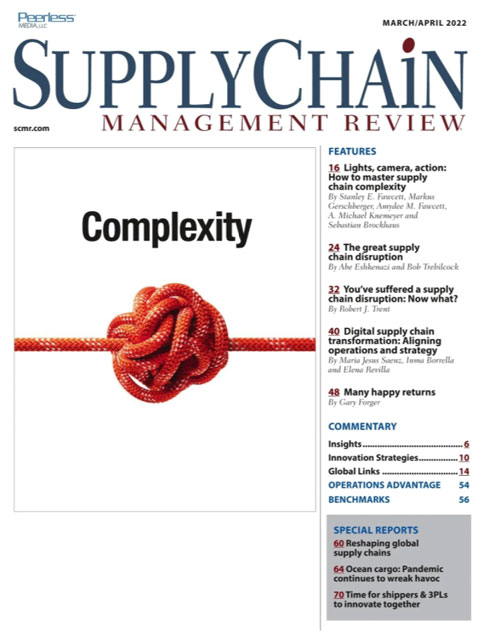Sorry, but your login has failed. Please recheck your login information and resubmit. If your subscription has expired, renew here.
March-April 2022
Yesterday, I hosted a webinar on the steps supply chain leaders are taking to redesign their supply chains to cope with this period of unprecedented demand. Earlier last month, I attended the Manifest conference in Las Vegas. The exhibitors featured a lineup of supply chain startups while the attendee list was dominated by venture capital firms looking to get in on the action in our booming industry. This morning, one of the lead news stories is about another disruption threatening to bring global supply chains to a halt: Browse this issue archive.Need Help? Contact customer service 847-559-7581 More options
During and after the Great Recession forecasting and planning processes grappled with greater uncertainties and risks to future customer demand.
One of my concerns coming out of the recession was that executives would downplay or even disband their forecasting and sales and operations planning (S&OP) processes. That is, executive teams might turn sour on formal processes that had long monthly cycles, and that were too slow to take action given the demand volatility they faced. Instead, they would turn toward running things by the seat-of-their pants—rather than on a tactical S&OP process designed to navigate a company’s financial future—12 months to 18 months out. I wrote two articles on that subject. You can find references to those and other resources for this column at the end the article.
The S&OP rudder
In the first of the two columns, I compared the S&OP process to the rudder of a ship sailing in global waters. The job of the S&OP team is to keep the business on a trajectory that will meet strategic goals and annual financial performance objectives. Similarly, a ship’s navigation team constantly monitors and corrects for conditions that might veer the business from its intended course.
If you’ve seen the movie The Perfect Storm, you might recall how the captain attempted to navigate his fishing boat through gale-force winds and gigantic waves. Those waves were not unlike the impact of the Great Recession on demand, as consumers and businesses alike stopped spending. The last thing anyone wanted was for the business to sink under that last big wave just before the economy improved.
Rather than giving up on S&OP, I advised executive teams to stay the course, change focus as necessary and utilize the S&OP team as a reliable rudder. Otherwise, their company would be dangerously bobbing along in a stormy sea, as executives barked orders with nothing to steer the ship.

This complete article is available to subscribers only.
Log in now for full access or start your PLUS+ subscription for instant access.
SC
MR
Sorry, but your login has failed. Please recheck your login information and resubmit. If your subscription has expired, renew here.
March-April 2022
Yesterday, I hosted a webinar on the steps supply chain leaders are taking to redesign their supply chains to cope with this period of unprecedented demand. Earlier last month, I attended the Manifest conference in… Browse this issue archive. Access your online digital edition. Download a PDF file of the March-April 2022 issue.During and after the Great Recession forecasting and planning processes grappled with greater uncertainties and risks to future customer demand.
One of my concerns coming out of the recession was that executives would downplay or even disband their forecasting and sales and operations planning (S&OP) processes. That is, executive teams might turn sour on formal processes that had long monthly cycles, and that were too slow to take action given the demand volatility they faced. Instead, they would turn toward running things by the seat-of-their pants—rather than on a tactical S&OP process designed to navigate a company’s financial future—12 months to 18 months out. I wrote two articles on that subject. You can find references to those and other resources for this column at the end the article.
The S&OP rudder
In the first of the two columns, I compared the S&OP process to the rudder of a ship sailing in global waters. The job of the S&OP team is to keep the business on a trajectory that will meet strategic goals and annual financial performance objectives. Similarly, a ship’s navigation team constantly monitors and corrects for conditions that might veer the business from its intended course.
If you’ve seen the movie The Perfect Storm, you might recall how the captain attempted to navigate his fishing boat through gale-force winds and gigantic waves. Those waves were not unlike the impact of the Great Recession on demand, as consumers and businesses alike stopped spending. The last thing anyone wanted was for the business to sink under that last big wave just before the economy improved.
Rather than giving up on S&OP, I advised executive teams to stay the course, change focus as necessary and utilize the S&OP team as a reliable rudder. Otherwise, their company would be dangerously bobbing along in a stormy sea, as executives barked orders with nothing to steer the ship.
 SUBSCRIBERS: Click here to download PDF of the full article.
SUBSCRIBERS: Click here to download PDF of the full article.
SC
MR


More Risk Management
- Israel, Ukraine aid package to increase pressure on aerospace and defense supply chains
- How CPG brands can deliver on supplier diversity promises
- How S&OP provides the answer to in-demand products
- There is still work to do to achieve supply chain stability
- Blooming success: The vital role of S&OE in nurturing global supply chains
- How one small part held up shipments of thousands of autos
- More Risk Management
Latest Podcast

 Explore
Explore
Topics
Procurement & Sourcing News
- Israel, Ukraine aid package to increase pressure on aerospace and defense supply chains
- How CPG brands can deliver on supplier diversity promises
- How S&OP provides the answer to in-demand products
- There is still work to do to achieve supply chain stability
- Blooming success: The vital role of S&OE in nurturing global supply chains
- How one small part held up shipments of thousands of autos
- More Procurement & Sourcing
Latest Procurement & Sourcing Resources

Subscribe

Supply Chain Management Review delivers the best industry content.

Editors’ Picks






